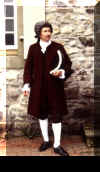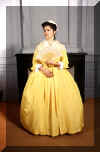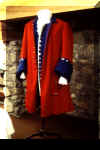
Behind Website Design and Content © by
Eric Krause, Krause House Info-Research Solutions
(© 1996)
All Images ©
Parks Canada Unless Otherwise Designated
Researching
the Fortress of Louisbourg National Historic Site of Canada
Recherche sur la Forteresse-de-Louisbourg Lieu historique national du Canada
Search All Sites/All Menus ~
Cherche Tous les Sites/Tous les Menus
Behind The Scenes Site

Note: Please click on an image to enlarge it
The Fortress of Louisbourg National Historic
Site possesses a large and varied collection of reproduction
costumes, numbering in excess of 4000 individual pieces. From
June until mid-October, staff dressed in reproduction period costume interpet the site to
the year 1744. Aspects of both civilian and military life are
reflected through costume, as are a variety of classes, ranks and
occupational groups. Interpretive staff are dressed as fishermen,
merchants, soldiers, servants and as the elite of Louisbourg
society. Costume, therefore, has a significant role in the
interpretation of the Fortress. Without a word being spoken a
visitor can assess whether an animator is a soldier or a
fisherman, whether a lady or her servant.
staff dressed in reproduction period costume interpet the site to
the year 1744. Aspects of both civilian and military life are
reflected through costume, as are a variety of classes, ranks and
occupational groups. Interpretive staff are dressed as fishermen,
merchants, soldiers, servants and as the elite of Louisbourg
society. Costume, therefore, has a significant role in the
interpretation of the Fortress. Without a word being spoken a
visitor can assess whether an animator is a soldier or a
fisherman, whether a lady or her servant.
The reproduction costumes worn at the Fortress are based on the styles of clothing worn in eighteenth-century Europe and more specifically, in France. French tastes and fashion were widely copied throughout Europe and, of course, at Louisbourg. Louisbourg was an important trading centre, so the majority of goods, including fabric were imported. Given its commercial orientation, the people of Louisbourg probably managed to stay reasonably abreast of current fashion.
 A well-to-do man of the
eighteenth-century wore a suit consisting of knee breeches, a
waistcoat and a coat or "justaucorps". The collarless
coat had large, turn-back cuffs, with side and back vents as well
as pleats in the side that were stiffened and padded. The
waistcoat was cut along similar lines as the coat but it was
shorter and did not have the pleats or, by the 1740's, sleeves.
The breeches, loose-fitting in the seat, were gathered into a
waistband and had a front button fly closure. They were fastened
below the knee by buckles. Under his suit a gentleman would have
worn a fine linen shirt with linen or lace ruffles at the wrists
and at the front opening of the shirt. Other features of
eighteenth-century gentlemen's dress were leather shoes that
fastened over the tongue with buckles, a wig that tied in the
back with a silk ribbon, and a three-cornered hat, called a tricorn.
A well-to-do man of the
eighteenth-century wore a suit consisting of knee breeches, a
waistcoat and a coat or "justaucorps". The collarless
coat had large, turn-back cuffs, with side and back vents as well
as pleats in the side that were stiffened and padded. The
waistcoat was cut along similar lines as the coat but it was
shorter and did not have the pleats or, by the 1740's, sleeves.
The breeches, loose-fitting in the seat, were gathered into a
waistband and had a front button fly closure. They were fastened
below the knee by buckles. Under his suit a gentleman would have
worn a fine linen shirt with linen or lace ruffles at the wrists
and at the front opening of the shirt. Other features of
eighteenth-century gentlemen's dress were leather shoes that
fastened over the tongue with buckles, a wig that tied in the
back with a silk ribbon, and a three-cornered hat, called a tricorn.
The fashionable female silhouette was created by wearing a
boned corset, or "stays" and a hooped petticoat. Stays were made by sewing pockets
into layers of linen. Strips of whalebone were inserted into
these narrow pockets thereby creating a stiff garment. The hooped
petticoat was also made by forming pockets in which whalebone or
cane were inserted. Under these garments was worn an
ankle-length, linen shift. Over the corset and petticoats was
worn a saque gown, a very popular style of dress during the first
half of the eighteenth-century. Panels of fabric were formed into
pleats across the back, which fell in graceful folds from the
back of the shoulders to the ground. The front of the gown was
often cut so that the front of the corset and the front of a
petticoat were displayed.
Stays were made by sewing pockets
into layers of linen. Strips of whalebone were inserted into
these narrow pockets thereby creating a stiff garment. The hooped
petticoat was also made by forming pockets in which whalebone or
cane were inserted. Under these garments was worn an
ankle-length, linen shift. Over the corset and petticoats was
worn a saque gown, a very popular style of dress during the first
half of the eighteenth-century. Panels of fabric were formed into
pleats across the back, which fell in graceful folds from the
back of the shoulders to the ground. The front of the gown was
often cut so that the front of the corset and the front of a
petticoat were displayed.
In contrast to the fine linens, silks and wools worn by the well-to-do members of society, working men and women wore garments made of hard-wearing, coarser materials. Their clothes were often well-patched and ill-matching. Working people might have purchased some of their clothing , ready-made, at an auction. A fisherman wore a heavy linen shirt, woolen or canvas trousers and perhaps a pair of wooden shoes; while a servant wore a linen shift, a pair of stays, a skirt or "petticoat" and a jacket. An apron was worn to protect her clothing and a linen cap to cover her head.
The reproduction costume program at the Fortress was officially started in 1969-70 and over the last 25 year, the collection has grown in size and complexity. Today, the Costume Department is housed in one of the reconstructed buildings. We are responsible for a range of activities including: costume issue and return, costume maintenance and inventory, research, pattern and garment production, staff training, costume loans, tours of the department, and answering requests for information from visitors and other institutions.
Over the years a variety of problems relating to the realities of providing hundreds of costumes to interpreters and volunteers has prompted a re-evaluation of the existing costume stock and the methods of production. More durable objects such as furnishings are replaced infrequently so there are fewer opportunities to reasess either the documentation on which the reproductions are based or the reproductions themselves. Costume, however, invites constant re-evaluation. The perishable nature of clothing necessitates its constant replacement and by extension not only allows but encourages its re-evaluation. Given the size and scope of the interpretive program at the Fortress of Louisbourg, costume pieces are constantly wearing out. We are, therefore, able to re-evaluate on an on-going basis, both the documentation and the production techniques that we use to reproduce eighteenth-century costumes.
Obviously, an accurately presented costume program cannot exist without a sound research base. The major sources of information about eighteenth-century costume include written primary and secondary sources, period illustrations and paintings, as well as original garments. At the outset, these sources are studied in order to determine the answers to fairly broad questions: what types of garments were worn in eighteenth-century Louisbourg? Who wore these garments and for what occasions? This type of information indicates the appropriateness of a costume to its historical period, to the recreated setting and to the role that the animator is portraying. Predominantly descriptive information is necessary in order to produce costumes that have the appearance of eighteenth-century clothing. This reinforces the visual function of reproduction costume. Beyond the mere appearance, however, we are attempting to determine how eighteenth-century garments were actually cut and constructed, and we are trying to integrate this type of research into the construction of our reproduction costumes.
As with any research process, the documentation must be evaluated for its accuracy, usefulness or biases. The documentation on period clothing, by its very nature, imposes limitations on the costume program. For example, the written documentation specific to the Fortress of Louisbourg is limited to post-mortem inventories and the material evidence to archaeological fragments. Post-mortem inventories frequently list specific items of clothing owned by Louisbourg residents. Sometimes, the fabrics that these garments were made of are also briefly described. Unfortunately, however, the inventories do not describe clothing in sufficient detail to produce specific garments. Archaeological artifacts excavated at Louisbourg provide us with information about clothing accessories such as buttons, buckles and shoes. Again, the information supplied by these artifacts alone is rarely sufficient to reproduce entire garments.
Patterns and construction information can be obtained by
studying original, eighteenth-century garments and this
information can be augmented by other primary documentary
sources. Original garments
in museum collections are not only unrelated to Louisbourg, but
tend to lean heavily toward clothing worn by the well-to-do
members of society rather than towards the broad spectrum of
social classes. Working class clothing is almost non-existent,
largely due to the fact that working clothing seldom survives and
in the past has not been valued either by donors or institutions.
Finally, primary documentary sources must also be evaluated for
their limitations. For example, during the eighteenth-century
when there was little standardization in terms of clothing
production, we must question whether the measurements and
construction information found in encyclopeadias such as Des Arts
et Metiers can be accepted as representative. Each of these
sources, therefore, is a valuable tool, but each also has its
limitations. The weakness of one source may be the strength of
another. Consulted together, these sources provide significant
information about eighteenth-century clothing.
Original garments
in museum collections are not only unrelated to Louisbourg, but
tend to lean heavily toward clothing worn by the well-to-do
members of society rather than towards the broad spectrum of
social classes. Working class clothing is almost non-existent,
largely due to the fact that working clothing seldom survives and
in the past has not been valued either by donors or institutions.
Finally, primary documentary sources must also be evaluated for
their limitations. For example, during the eighteenth-century
when there was little standardization in terms of clothing
production, we must question whether the measurements and
construction information found in encyclopeadias such as Des Arts
et Metiers can be accepted as representative. Each of these
sources, therefore, is a valuable tool, but each also has its
limitations. The weakness of one source may be the strength of
another. Consulted together, these sources provide significant
information about eighteenth-century clothing.
Supported by the available knowledge of the appearance and construction of eighteenth-century costume and the context of its use, the actual production of costume requires continuous decision making, including decisions relating to the kind of reproduction that will be made. Broadly speaking, costumes fall into three categories. They may be stitch-for-stitch "replicas" of original garments, "reproductions" based on period construction techniques, but which include some compromises such as the use of machine stitching on interior seams, or, finally, they may be "adaptations" which are essentially modern garments inspired by eighteenth-century design.
Obviously, historic adaptations are inappropriate in the context of the recreated physical setting of the Fortress. The choice must then be made between replicas and reproductions. Operational realities, in particular financial limitations, dictate the choice between these two options. Constructing large quantities of garments completely by hand, using period construction techniques, is very labour intensive and requires a large staff of skilled, well-trained seamstresses. Consequently, replicas are an expensive undertaking, particularly given the large and constantly changing nature of Louisbourg's seasonal staff. In fact, early reproduction garments made at the Fortress of Louisbourg were, on some levels, treated as replicas. For example, many of the early costumes were made of fabric woven at the site; other garments were hand quilted and embroidered. As the interpretive programs and the demand for costumes grew, the weaving program - a very labour intensive program - was phased out. Ironically, the operation of a historic site which strives for historical accuracy in turn imposes limitation on the costume program. Naturally, compromises are introduced as we try to strike a balance between these operational demands and accurate, durable costumes.
The notion that curators at historic sites must provide a
three-dimensional, useable product differentiates their role from
those of other museum professionals. The translation of written
documentation or limited material evidence into a wearable
garment is, in effect, a form of applied history and is an
extremely important part of the overall research process. By using period construction
techniques it is possible to learn a great deal about how and why
garments were constructed in a particular way during the
eighteenth-century. In addition, the process forces us to abandon
our twentieth-century notions of clothing production and yet
produce garments that not only meet the needs of a modern
interpretation program, but the demand for historical accuracy.
By using period construction
techniques it is possible to learn a great deal about how and why
garments were constructed in a particular way during the
eighteenth-century. In addition, the process forces us to abandon
our twentieth-century notions of clothing production and yet
produce garments that not only meet the needs of a modern
interpretation program, but the demand for historical accuracy.
The drive for historical accuracy or authenticity is a philosophy that governs most aspects of living history sites. Occasionally the question arises, why are we so concerned with such precise accuracy? In some ways, the importance of historical accuracy was reinforced to us during the summer of 1995 when the Fortress of Louisbourg hosted a "Grand Encampment". The summer of 1995 marked the 275th anniversary of the official founding of Louisbourg and the 250th anniversary of the first siege. As part of the summer-long celebrations, an encampment was planned at the Fortress: over 1200 reenactors from Canada and the United States set up camp at the site for three days at the end of July. With so many visitors, who had such a keen interest in eighteenth-century history and material culture, the Fortress of Louisbourg was under close scrutiny. Of course, this scrutiny also included the reproduction costume program. The praise and criticism that we received reminded us of the difficulties of trying to present a truly authentic costume program and the need for continued research about period dress.